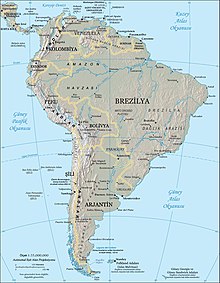Oligoryzomys nigripes, also known as the black-footed colilargo[2] or the black-footed pygmy rice rat,[1] is a rodent in the genus Oligoryzomys of family Cricetidae. Oligoryzomys nigripes is a species that has been further divided into different sister taxa throughout history. It is found in different countries in South America.[3] It is a large species with long ears, dark yellow to dark brown upperparts, sharply delimited from the whitish underparts, and often a pink girdle on the chest. This species of rat spends much of its life among the trees.[4] The karyotype is 2n = 62, FNa = 78–82.[3]
| Oligoryzomys nigripes | |
|---|---|
| Scientific classification | |
| Domain: | Eukaryota |
| Kingdom: | Animalia |
| Phylum: | Chordata |
| Class: | Mammalia |
| Order: | Rodentia |
| Family: | Cricetidae |
| Subfamily: | Sigmodontinae |
| Genus: | Oligoryzomys |
| Species: | O. nigripes
|
| Binomial name | |
| Oligoryzomys nigripes (Olfers, 1818)
| |
| Synonyms | |
| |

Synonym species
editTwo other species, Oligoryzomys delticola (also known as the delta pygmy rice rat[5] or the large colilargo)[2] and Oligoryzomys eliurus (also known as the Brazilian pygmy rice rat[6] or the Brazilian colilargo)[2] have been recognized as synonyms of O. nigripes since 2005; they cannot be distinguished on the basis of morphology, karyotype, or morphometrics.
Location
editOligoryzomys nigripes is found from Pernambuco in northeastern Brazil through the Atlantic Forest and Cerrado into Paraguay, Uruguay, and Argentina, where it occurs in the provinces of Chaco, Misiones, and Buenos Aires.[3]
Morphology
editThe pelage colors for this species resemble brown, dark yellow, and grey.[7] This species of Oligoryzomys have small bodies and long tails.[4] The totaled head plus body length of the model species for O. nigripes is 9 cm.[8] The tail length for the model species for O. nigripes is 10.5 cm.[8] The weight of the animal ranges from 26.32 grams to 33.3 grams.[8] The eyes of this species are rounded and jet black.
Behavior
editOligoryzomys nigripes is a nocturnal species of rodent.[4] They live entirely on land and many of them dwell in the trees.[4] They are proficient at climbing these trees.[9] This species is a known insectivore, but can be frugivorous. Therefore, O. nigripes is considered an omnivore.[9] They scavenge for nutrient sources in things such as fruits, insects, and seeds.[4]
Karyotype
editThere are 31 pairs of chromosomes found in the Oligoryzomys nigripes species.[10] The diploid formula for this species is 2n=62.[10] There are 60 autosomal chromosomes and 2 sex chromosomes found in this species.[10]
References
edit- ^ a b Weksler et al., 2008
- ^ a b c Musser, G. G.; Carleton, M. D. (2005). "Superfamily Muroidea". In Wilson, D. E.; Reeder, D. M. (eds.). Mammal Species of the World: A Taxonomic and Geographic Reference (3rd ed.). Johns Hopkins University Press. p. 1143. ISBN 978-0-8018-8221-0. OCLC 62265494.
- ^ a b c Weksler, M. & Bonvicino, C.R. 2005. Taxonomy of pygmy rice rats genus Oligoryzomys Bangs, 1900 (Rodentia, Sigmodontinae) of the Brazilian Cerrado, with the description of two new species. Arquivos do Museu Nacional 63(1):119.
- ^ a b c d e González-Ittig, Raul E.; Rivera, Paula C.; Levis, Silvana C.; Calderón, Gladys E.; Gardenal, Cristina N. (June 2014). "The molecular phylogenetics of the genus O ligoryzomys (Rodentia: Cricetidae) clarifies rodent host-hantavirus associations: Rodent Host-Hantavirus Genotype Relationships". Zoological Journal of the Linnean Society. 171 (2): 457–474. doi:10.1111/zoj.12133. hdl:11336/8004.
- ^ Pardinas and D'Elia, 2008
- ^ Leite, Y. and Patterson, B. 2008. Oligoryzomys nigripes. In IUCN. IUCN Red List of Threatened Species. Version 2009.2.
- ^ AGRELLOS, RODRIGO; BONVICINO, CIBELE R.; ROSA, ELIZABETH SALBÉ T.; MARQUES, APARECIDO A.R.; D’ANDREA, PAULO S.; WEKSLER, MARCELO (2012-03-02). "The taxonomic status of the Castelo dos Sonhos Hantavirus reservoir, Oligoryzomys utiaritensis Allen 1916 (Rodentia: Cricetidae: Sigmodontinae)". Zootaxa. 3220 (1): 1. doi:10.11646/zootaxa.3220.1.1. ISSN 1175-5334. S2CID 88269086.
- ^ a b c Mario, Lara Carolina; Borghesi, Jéssica; G. Hayashi, Rafael; O. Favaron, Phelipe; N. Rodrigues, Marcio; C. Carvalho, Rafael; Miglino, Maria A. (2018-06-04). "Morphology of the Oligoryzomys nigripes respiratory system". Anatomia, Histologia, Embryologia. 47 (4): 364–371. doi:10.1111/ahe.12363. ISSN 0340-2096. PMID 29869399.
- ^ a b de França Silveira Ribeiro, Martim; da Rocha, Pedro Luiz Bernardo; Mendes, Lys Angela Favaroni; Perry, Steven Franklin; Oliveira, Elisabeth Spinelli de (August 2004). "Physiological effects of short-term water deprivation in the South American sigmodontine rice rat Oligoryzomys nigripes and water rat Nectomys squamipes within a phylogenetic context". Canadian Journal of Zoology. 82 (8): 1326–1335. doi:10.1139/z04-104. ISSN 0008-4301.
- ^ a b c de Almeida, Eunice Judith Cardoso; Yonenaga-Yassuda, Yatiyo (January 1991). "Pericentric inversions and sex chromosome heteromorphisms inOryzomys nigripes(Rodentia, Cricetidae)". Caryologia. 44 (1): 63–73. doi:10.1080/00087114.1991.10797020. ISSN 0008-7114.
